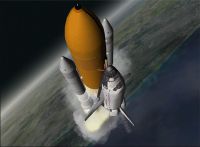Space Shuttle Atlantis
Space Shuttle Atlantis represents the only “real” spacecraft in the basic Orbiter distribution (but there are many more available as addons). Its flight characteristics are less forgiving than fictional models like the Delta-glider, and just reaching orbit is a challenge.
The Atlantis orbiter features a working payload bay with remote manipulator system (“Canadarm”), so you can simulate the deployment or even recapture of satellites, or the shipment of resupplies to the International Space Station.
The model now also features a virtual cockpit, with working MFD instruments and heads-up display.
Launch:
- Fire main engines at 100%.
- SRBs are ignited automatically when main engines reach 95%. SRBs are not controlled manually. Once ignited, they cannot be shut off.
- During launch, attitude is controlled via SRB thrust vectoring. Roll shuttle for required heading, and decrease pitch during ascent for required orbit insertion.
- SRBs separate automatically at T+2:06min. In an emergency, SRBs can be jettisoned manually with E.
- Ascent continues with Orbiter main engines. Throttle down as required for 3g max acceleration.
- Tank separates at T+8:58min (alt 110km) when empty, or manually with E.
- After tank separation, orbiter switches to OMS (orbital maneuvering system) using internal tanks, for final orbit insertion. Attitude thrusters (RCS – reaction control system) are activated.
NOTE: Auto guidance & auto pilot systems have been added in the newest version. Suffice to say, the beast has been tamed.
Docking:
- The orbiter carries a docking attachment in the cargo bay.
- Open cargo bay doors before docking.
- Docking direction is in orbiter’s +y direction (up). The Docking MFD must be interpreted accordingly.
RMS manipulation and grappling:
- The shuttle carries a mechanical manipulator arm in the cargo bay which can be used for releasing and recapturing satellites, MMU control, etc.
- The arm can be used in orbit once the cargo doors have been fully opened. To bring up the RMS control dialog, press Ctrl + Space.
- The arm has three joints: the shoulder joint can be rotated in yaw and pitch, the elbow joint can be rotated in pitch, and the wrist joint can be rotated in pitch, yaw and roll.
- To grapple a satellite currently stowed in the cargo bay, move the RMS tip onto a grappling point, and press “Grapple”. If grappling was successful, the button label switches to “Release”.
- To make it easier to identify the grappling points of satellites, you can tick the “Show grapple points” box. This marks all grappling points with flashing arrows.
- To release the satellite, press “Release”.
- You can also grapple freely drifting satellites if you move the RMS tip onto a grappling point.
- To return a satellite back to Earth, it must be stowed in the cargo bay. Use the RMS arm to bring the satellite into its correct position in the payload bay. When the Payload “Arrest” button becomes active, the satellite can be fixed in the bay by pressing the button. It is automatically released from the RMS tip.
- The RMS arm can be stowed in its transport position by pressing the RMS “Stow” button. This is only possible as long as no object is attached to the arm.
- Payload can be released directly from the bay by pressing the “Purge” button.
